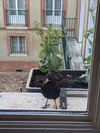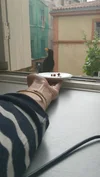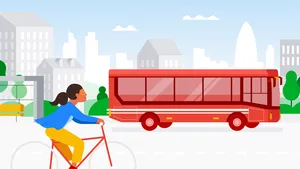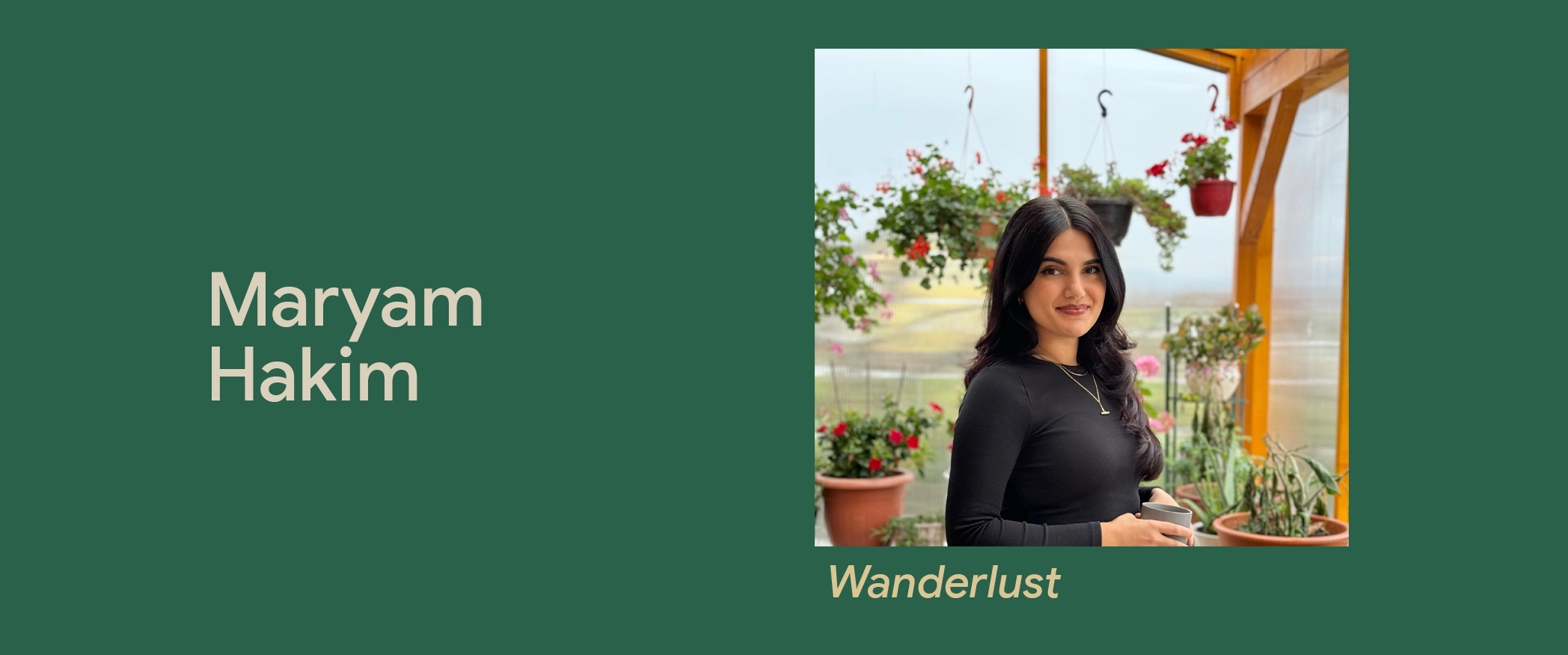Wie Mélanie mithalf, eine „Öko-Ampel“ für 500.000 Lebensmittel zu entwickeln

This article is also available in English. You can find it below the German version. Diesen Artikel gibt es auch auf Englisch. Ihr findet die englische Version weiter unten.
Als Mélanie Gancel während der Corona-Pandemie nur wenige Leute sehen konnte, fand sie am Fenster ihrer Toulouser Altbauwohnung einen neuen Freund: Edmond, die Amsel. Mélanie spendierte ihm immer wieder mal ein paar Rosinen und so kam Edmond bei jedem Besuch ein bisschen näher. Heute sitzt er sogar manchmal bei ihr im Wohnzimmer auf der Couch. „Es ist eine besondere Magie in der Luft, wenn wir uns mit anderen Lebewesen austauschen“, sagt Mélanie, die auch durch Edmond ein besonderes Verhältnis zur Natur entwickelt hat. Nachdem sie auch viel über den Klimawandel gelesen hatte, beschloss sie, möglichst große Teile ihrer Arbeitszeit dem Thema Nachhaltigkeit zu widmen.

Im Jahr 2020 ergab sich dafür eine gute Gelegenheit. Die kleine gemeinnützige Organisation Open Food Facts zählte bei der Google.org Impact Challenge zu den ausgewählten Projekten. Teil der Förderung waren mehrere „Fellowships“, also Google-Mitarbeiter:innen, die für sechs Monate pro bono bei der Organisation mitarbeiten. Eine jener „Fellows“ war Mélanie. „Open Food Facts suchte damals eine Marketing-Expertin, die mithalf, für das Konzept einer „Lebensmittel-Öko-Ampel“ mehr Aufmerksamkeit zu schaffen und die Idee, zusammen mit einem Team von Ingenieuren, zu skalieren“, erzählt Mélanie. Und das hat offenbar bestens funktioniert. Am Ende des Fellowships hatte sich die Zahl der erfassten und mit einem „Eco-Score“ bewerteten Lebensmittel von 70.000 auf über 500.000 mehr als versiebenfacht. Verantwortlich dafür seien in erster Linie Googles Software-Ingenieure gewesen, die mit Hilfe von Künstlicher Intelligenz den „Eco-Score“ automatisch für hunderttausende weiterer Produkte berechnen halfen.

Mélanie zusammen mit dem Team von „Open Food Facts“

Wie funktionieren „Eco-Score“ und „Open Food Facts“?
Der „Eco-Score“ soll die Nachhaltigkeit von Produkten auf einen Blick sichtbar machen. Das tiefgrüne A steht für die besten, ein rotes E für die schlechtesten Werte. In die Berechnung der Bewertung fließen zum einen die Umweltwirkungen eines Produkts über die gesamte Wertschöpfungskette ein, zum anderen aber auch weitere Kriterien wie Transport oder Recyclingfähigkeit. Über „Open Food Facts“ werden detaillierte Daten über eine Vielzahl von Produkten in das „Eco-Score“-System eingespeist. Außerdem können Verbraucher:innen mit Hilfe der Open-Food-Facts-App Produkte scannen und mehr über deren „Eco-Score“ erfahren. In Deutschland wird das Label bereits vom Discounter Lidl erfolgreich eingesetzt.

Mélanie Gancel freut sich über den Erfolg ihrer Partner von Open Food Facts. Besonders als das Projekt auch dank ihrer Hilfe auf einem Panel mit der französischen Staatssekretärin Olivia Grégoire sowie bei der Klimakonferenz COP26 vorgestellt wurde. „Das waren schöne Momente“, sagt Mélanie bescheiden. Besonders gefällt ihr am Öko-Label für Lebensmittel, dass es so einfach und doch so wirksam ist. „Es ist kein Raumschiff, um fremde Planeten zu entdecken. Es funktioniert im Alltag und lässt sich mit Technologie perfekt skalieren.“ Und es hat im Kampf gegen den Klimawandel ein erhebliches Gewicht, über ein Drittel der klimarelevanten Emissionen ist auf das globale Ernährungssystem zurückzuführen.
Edmond, die Amsel, braucht zum Glück kein „Eco-Label“. Er freut sich über ein paar Rosinen, die ihm Mélanie auch heute Abend wieder auf ihr Fensterbrett legen wird.

How Mélanie helped to develop an "eco traffic light" for 500,000 food products
When Mélanie Gancel could only see a few people during the corona pandemic, she found a new friend at the window of her old apartment in Toulouse: Edmond the blackbird. Mélanie kept giving him a few raisins every now and then, and so Edmond got a little closer with each visit. Today he sometimes even sits with her in the living room on the couch."There is something special happening when we interact with other species" says Mélanie, who found in Edmond a playful way of connecting with nature. During the pandemic she also read a lot about climate change which motivated her to devote as much of her working time as possible to the topic of sustainability.
A good opportunity arose in 2020. The small French non-profit organization Open Food Facts was among the recipients of the Google.org Impact Challenge. On top of the funding, some nonprofits received a Google.org Fellowship, i.e. Google employees who work with the organization for six months full-time pro-bono. One of those fellows was Mélanie. “At the time, Open Food Facts was looking for a marketing expert who would help to raise awareness for an “eco traffic light” for food and together with a team of engineers scale it internationally” says Mélanie. And that apparently worked fine. At the end of her fellowship, the number of foods recorded and evaluated with an “Eco-Score” had increased more than sevenfold from 70,000 to over 500,000. Mélanie believes that Google's software engineers were primarily responsible for this, using artificial intelligence to scale and to automatically compute an Eco-Score across hundreds of thousands of new products.

How do "Eco-Score" and "Open Food Facts" work?
The "Eco-Score" is intended to make the sustainability of food products visible at a glance. The deep green A stands for the best, a red E for the worst values. The calculation of the rating includes the environmental impact of a product along the entire value chain, as well as other criteria such as transport or recyclability. Detailed data on a large number of products is fed into the "Eco-Score" system via "Open Food Facts". In addition, consumers can use the Open Food Facts app to scan products and find out more about their "Eco Score". In Germany, the discounter Lidl is already using the label successfully.
Mélanie Gancel is pleased with the success of her partners from Open Food Facts. Especially when the project was presented thanks to her help on a panel organised with FR secretary of state Olivia Grégoire for social economy and at the COP26 climate conference. "It was a good moment," says Mélanie modestly. What she particularly likes about the eco-label for food is that it is so simple and yet so effective. "It's not a spaceship to find another planet. It works in everyday life and scales perfectly with technology.” And it is of considerable importance in the fight against climate change, more than a third of climate-relevant emissions can be traced back to the global food system.
Luckily, Edmond the blackbird doesn't need an "eco-label". He's happy about a few raisins, which Mélanie will put on her window sill again tonight.






